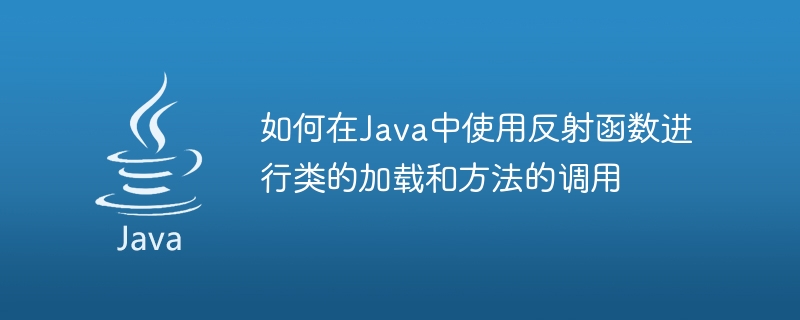

How to use reflection function to load classes and call methods in Java
Overview:
Reflection (Reflection) is a powerful mechanism in Java , which allows us to dynamically obtain class information at runtime, call methods of the class in the program, and create objects of the class. In Java, we can use the reflection mechanism to implement class loading and method invocation, which greatly improves the flexibility and scalability of the program. This article will introduce in detail how to use reflection functions to load classes and call methods in Java, and provide specific code examples.
Class loading:
Class loading refers to the process of loading the class file into memory and creating a Class object for it. In Java, there are three ways to load a class:
Specific example:
The following takes the Class.forName() method to load a class as an example to show how to use the reflection function to load a class.
public class ReflectDemo {
public static void main(String[] args) {
try {
// 加载类
Class<?> clazz = Class.forName("com.example.MyClass");
// 创建对象
Object obj = clazz.newInstance();
// 调用方法
Method method = clazz.getMethod("print", String.class);
method.invoke(obj, "Hello, Reflection!");
} catch (ClassNotFoundException e) {
e.printStackTrace();
} catch (InstantiationException e) {
e.printStackTrace();
} catch (IllegalAccessException e) {
e.printStackTrace();
} catch (NoSuchMethodException e) {
e.printStackTrace();
} catch (InvocationTargetException e) {
e.printStackTrace();
}
}
}
class MyClass {
public void print(String message) {
System.out.println(message);
}
}In the above code, the class "com.example.MyClass" is first loaded using the Class.forName() method, and then the object is created by calling the newInstance() method. Then, get the Method object of the "print" method by calling the getMethod() method, and finally use the invoke() method to call the method and pass the parameters.
Method calling:
In Java, it is very simple to use reflection to call a method. You can obtain the Method object of the method through reflection, and then use the invoke() method to call the method.
Specific example:
The following uses reflection to call a method with parameters as an example to show how to use the reflection function to call the method.
public class ReflectDemo {
public static void main(String[] args) {
try {
// 加载类
Class<?> clazz = Class.forName("com.example.MyClass");
// 创建对象
Object obj = clazz.newInstance();
// 调用有参数方法
Method method = clazz.getMethod("print", String.class);
method.invoke(obj, "Hello, Reflection!");
} catch (ClassNotFoundException e) {
e.printStackTrace();
} catch (InstantiationException e) {
e.printStackTrace();
} catch (IllegalAccessException e) {
e.printStackTrace();
} catch (NoSuchMethodException e) {
e.printStackTrace();
} catch (InvocationTargetException e) {
e.printStackTrace();
}
}
}
class MyClass {
public void print(String message) {
System.out.println(message);
}
}In the above code, the Method object of the "print" method is obtained by calling the getMethod() method, and String.class is passed as the parameter type. Then use the invoke() method to call the method and pass the parameters.
Summary:
Through reflection, classes can be dynamically loaded and methods called at runtime, which greatly improves the flexibility and scalability of the program. In Java, we can use methods such as Class.forName() to load classes, use methods such as getMethod() to obtain method information, and use the invoke() method to call methods. When using the reflection mechanism, you need to pay attention to performance issues. Excessive use may lead to performance degradation, so it needs to be used with caution in actual development. I hope the content of this article can help you understand how to use reflection functions to load classes and call methods in Java.
The above is the detailed content of How to use reflection functions to load classes and call methods in Java. For more information, please follow other related articles on the PHP Chinese website!
